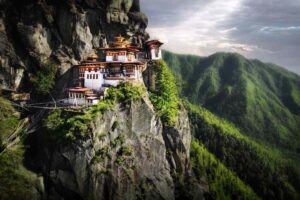
Bhutan’s Weather:
Because Bhutan is so mountainous, its weather can’t be summed up in a few words. Bhutan’s weather is completely determined by its elevation. When you go south, closer to India, it gets cool in the winter and hot and humid in the summer. In the northern parts of the state, where the mountains reach up to 7,000 meters, the weather is similar to the Arctic. Let’s talk about when is the best time to go to Bhutan.
During the wet season, it usually rains a lot. People think that winter is the best time to visit the lower parts of Bhutan because the weather is usually nice. But right now, the higher parts are freezing. So, the best times to visit Bhutan are in the fall (late September to November) and spring (March to May), when the weather is dry, sunny, and warm. But no matter what time of year you go, make sure you bring warm clothes.
MONTHS:
THE BEST TIME TO GO TO BHUTAN
A THIMPHU
BUMTHANG
PARO
PUNAKHA
TRASHIGANG
A MONGAR
TRONGSA
JANUARY
12.3°C to 2.6°C
10.8°C to 5.1°C
9.4°C to 5.8°C
17.0°C to 4.3°C
20.4°C to 10.5°C
15.5°C to 8.2°C
10.8°C to 5.1°C
FEBRUARY
14.4°C – 0.6°C
10.0°C to 1.4°C
13.0°C to 1.5°C
19.0°C to 7.8°C
21.7°C to 11.5°C
15.9°C to 8.3°C
10.0°C to 1.4°C
MARCH
16.4°C to 3.9°C
16.2°C to 3.5°C
14.5°C – 0.6°C
22.8°C to 10.4°C
24.8°C to 14.4°C
20.0°C to 11.6°C
16.2°C to 3.5°C
APRIL
20.0°C to 7.1°C
18.7°C to 3.9°C
17.6°C to 4.6°C
26.2°C to 12.9°C
28.3°C to 17.0°C
22.8°C to 14.0°C
18.7°C to 3.9°C
MAY
22.5°C to 13.1°C
21.3°C to 9.5°C
23.5°C to 10.6°C
29.1°C to 17.7°C
30°C to 22.6°C
25.1°C to 17.4°C
21.3°C to 9.5°C
JUNE
24.4°C to 15.2°C
22.5°C to 13.5°C
25.4°C to 14.1°C
29.2°C to 20.1°C
30.7°C to 22.6°C
26.1°C to 19.5°C
22.5°C to 13.5°C
JULY
25.9°C to 15.6°C
– 13.6°C–24.1°C
26.8°C to 14.9°C
30.4°C to 20.5°C
– 23.1°C-31.5°C
27.1°C to 19.8°C
– 13.6°C–24.1°C
AUGUST
25.0°C to 15.8°C
23.0°C to 13.7°C
25.3°C to 14.7°C
29.1°C to 20°C
30.2°C to 22.7°C
25.4°C to 19.6°C
23.0°C to 13.7°C
September
23.1°C to 15°C
21.6°C to 12.1°C
23.4°C to 11.7°C
27.5°C to 19.1°C
30.0°C to 21.9°C
24.7°C to 19.4°C
21.6°C to 12.1°C
OCTOBER
21.9°C to 10.4°C
19.5°C to 5.9°C
18.7°C to 7.4°C
26.1°C to 14.7°C
29.1°C to 17.7°C
22.7°C to 15.8°C
19.5°C to 5.9°C
NOVEMBER
17.9°C to 5°C
16.1°C – 0.5°C
13.9°C to 1.4°C
22.6°C to 9.6°C
26.1°C to 13.6°C
19.9°C to 11.2°C
16.1°C – 0.5°C
DECEMBER
14.5°C – 1.1°C
12.3°C to 2.3°C
11.2°C to 1.7°C
19.1°C to 6.3°C
23.0°C to 11.6°C
17.7°C to 9.5°C
12.3°C to 2.3°C
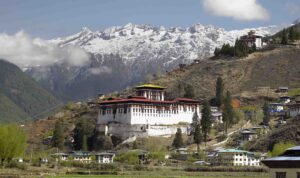
We have 4 seasons in Bhutan:
Spring: March through May
Summer, from June to August,
Fall: September through November
Winter, from December to February
When is the best time to visit Bhutan?
Most people agree that the best times to visit Bhutan are in the fall, from September to November, or in the spring, from March to May. The weather is usually warm and dry during these months, which is a nice change. The scenery is also at its most beautiful and impressive.
Tourist spots like the Tashichho Dzong, the Punakha Dzong, and the Taktsang Goemba can get very crowded in the fall and spring. The best time to visit Bhutan is during these seasons.
Spring:
People think that spring, which lasts from March to May, is the best season because it has so many beautiful colors. At this point, the valleys are green with new plants and the fruit trees are growing. This is also the time of year when people in the area are usually happy and friendly to visitors. This is thought to be the best time to go to Bhutan.
Fall:
The fall season, from September to November, is beautiful, with clear blue skies that make it easy to see the world’s largest unclimbed mountains. It’s the best time to go to Bhutan and a great time to travel and go on trips. The air is cool and calm, and there are great picture opportunities of willows losing their bright earthy leaves, parks that are far away from everything else, and sad views of dzongs and religious communities. When to go to Bhutan
Monsoon:
The monsoon season lasts from June to August. Bhutan gets more rain during this time than any other Himalayan country. With clear blue skies and warm weather, now is a lovely time to visit places of social and historical interest. However, this isn’t the best time to visit Bhutan or for flying.
Enjoy a cup of hot, sweet tea while you watch the rain fall from the window of your hotel room. It’s also possible to be brave and get an umbrella or jacket while it’s raining and take a walk around town instead. When to go to Bhutan
Winter:
From December to February, winter is bright, cool, and definitely nice. During the winter, a lot of the east-west highway is blocked by snow. It’s the best time to go to Bhutan, and Western cities like Paro, Punakha, Wangdue, Haa, and Thimphu are great places to see. In the winter, the beautiful Gangtey (Phobjikha) valley is one of the main draws. From there, you can see a large area of moving land with bamboo bushes.
Bhutan’s own festival:
Bhutanese festivals are known for being full of money, energy, and happiness. Old Buddhist stories and amazing victories are re-authorized and celebrated all over the country with such grandeur that it brings in tourists and visitors from all over the world. When to go to Bhutan
In Bhutan, celebrations are great times for whole networks to get together to see strict shows, give gifts, and talk to each other. Over-the-top dance performances in costumes, mind-blowing fire shows, stories told from legends, and expressive masks all bring out energy and zest. When to go to Bhutan
Festival of Nomads:
There is an event every year in Bumthang called the Nomad event. Nomadic people from all over Bhutan get together to celebrate. People who live on the move show off their traditions and way of life at this event. Events that stand out include the stylized imperial parade and lines of slows that include different local foods, phrases, and ways of life. When to go to Bhutan
Festival of the Gomphu Kora:
The Gomphu Kora Festival is the most important event for the people of Trashigang. It is a festival like no other in Bhutan. Before we can understand how important the event is, we need to know the story behind it.
Festival in Matsutake:
People who live in Ura Valley during the mushroom season really enjoy the Matsutake Festival. This event gives visitors a look into the lives of Bhutanese people who live nearby. Guests who take part can enjoy the mushroom-picking trip and relax in the beautiful Ura Valley’s woods and rough terrain.
Festival of Wangdue Phodrang Tshechu:
Lozeys are long, complicated songs and talks that come from the Wangdue Phodrang area. The event was held every year after the completion of a fortification in 1639. “The Dance of Ox” is the main attraction, and people dance to make sure they’ll be safe in the great beyond. After the spreading out of huge compositions called Guru Tshengye Thongdrol, the event is over. When to go to Bhutan
Festival of Thimphu Tshechu:
The biggest and best-known event in Bhutan is the Thimphu Tshechu event, which is also known as the National Festival of Bhutan. Before becoming the real Tshechu, people prayed for days and nights to call on the powerful gods. When to go to Bhutan.
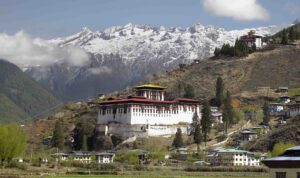
Festival of Nimalung:
People around the world love Bhutan’s beautiful events. The Nimalung Festival is one of Bhutan’s most important events. It’s hard for people who love Bhutanese cultures and traditions to miss this festival. They will love seeing the traditional dances and performances of people dressed in bright clothes. Many people in the area will also be wearing their best clothes during the event.
Festival of Jambay Lhakhang Drup:
At the Jambay Lhakhang Temple in Bumthang, there is a festival called the Jambay Lhakhang Drup. As early as the seventh century, Tibetan King Songsten Gampo built 108 temples. This is one of them. Different cover moves, called chams in the nearby language, make the event stand out.
Average Number of Tourists to Bhutan:
In 2018, Bhutan’s tourism business continued to grow, which was a big part of the country’s economic growth through things like income, foreign currency, and job creation. A total of 274,097 tourists from other countries came to Bhutan in 2018, which is 7.61% more than in 2017.
Relaxation looks around the world grew by 1.76 percent, to 63,367 more than in 2017, and looks from the local market grew by 10.37 percent.
As a viable travel industry goal, Bhutan keeps gaining momentum in the global travel industry network. This is clear from the growing popularity that leads to more visitors every year. In 2018, Bhutan was given the Earth Award by Green Destinations. This award was given to Bhutan because of its efforts and duty to take care of our planet.
Checked Out Places to See in Bhutan:
There are many places to visit in Bhutan. If you want to visit Bhutan, here is a full list of all the places you can see there. This will help you plan your trip.
Thimphu:
It is called the heart of Bhutan, and it is in the middlewestern part of the country. Let us know that Thimphu is also the capital of Bhutan. It became the capital after Punakha in 1961. This spot in Bhutan is also known for its lively nightlife.
It is one of the places in the country where Bhutanese customs are still alive. It has many traditional buildings, such as the Buddha Dordenma, which you can see as you enter Thimphu. The best things to see here are the library, the art school, the clothing museum, and the market on the weekends.
Paro International Airport is about an hour’s drive from Thimphu. Paro is a city that is a mix of old and new. Bhutan’s city is the only one that doesn’t have traffic lights.
Bumthang:
A beautiful mountain valley can be found in Bumthang. This area has a lot of old churches and temples. One of the best places to visit in Bhutan is Bumthang, which is famous for its history, faith, and spirituality.
Most people come to see Kurji and Tamshing Lakhang, and they can also go climbing on the hill. Hey.Bhutanese hold parties for nomads in Bumthang every year in February.
Paro:
Paro is a small town in Bhutan’s Paro Valley. It is home to 155 temples and shrines. A lot of people from all over the world come to visit Paro.
The town of Paro is on the banks of the Chu River and is about 2,280 meters above sea level. It covers an area of 1259 square meters. Also, say that it is the only international airport in Paro, Bhutan and that it is thought to be the hardest airport to land on.
There are a lot of interesting things to see and do in this area. Tiger’s Nest, also known as Takhtasang, is a famous monastery in Bhutan. It is built on a rock in the city of Paro. Besides this, there are many other popular tourist spots in Paro, such as temples and museums. Rinpung Dzong, the Bhutan National Museum, and the Paro Weekend Market are all great places to see in Paro.
Punakha:
Bhutan has 20 districts or Dzongkhags. Punakha is one of them. It is 1200 meters above sea level and has a great view of the Himalayas. Bhutan’s capital used to be Punakha until 1955 when it was moved to Thimphu.
This is a great place to go mountain biking and hiking. Besides this, the Po Choo River is where Bhutanese people go river rafting, which is one of their favorite outdoor sports. If you’re going to Bhutan, you have to also see Punakha.
Jakar:
It is the biggest and most beautiful valley in Bumthang. It is at the base of the Chokhor valley. Zakar is also known as “Little Switzerland.” The main city in charge of running the Bumthang area is Zakar.
There are monasteries and Dzongs spread out among tree-covered mountain ranges all around the area, making it a great place for history and nature fans alike. There are a lot of historical and holy places in Zakar.
It is thought to be where Buddhism in Bhutan began. Zakar is the place to go in Bhutan if you want to see some nature. Tourist spots can also be reached by other activities, such as hiking and mountain biking.
The Wangdue Phodrang:
Wangdew Phodrang is one of Bhutan’s biggest districts. It has everything from monasteries and temples to villages with animals and people living off the land. Wangchuck Centennial Park is in the north, and Jigme Dorji National Park is in the southeast. Both of these parks are home to many plant and animal types.
Rare animals like the red panda, snow leopard, blue sheep, and black bear can be seen by tourists. So can flowers, rhododendrons, and blue poppies. Wangdew Phodrang Tourism is a great spot for people who love the outdoors. It is a must that you visit the tourist spots in Wangdew Phodrang if you are going to Bhutan. When to go to Bhutan
Phuentsholing:
One of Bhutan’s borders is with the Indian state of West Bengal, which is home to the second-largest city in Bhutan. It is an important business hub for Bhutan and a way for people to get into the country from Kolkata and Siliguri. Phuntsholing is one of Bhutan’s more developed towns, but it still has a lot of natural interesting things to see.
Some of the places that tourists can see on foot are Zangto Pailari Lakhang, Karabandi Math, Bhutan Gate, and Kharbandi Gomba. This is a small temple to Guru Rinpoche called Zangto Pailari Lakhang. This is where the main entrance from India is, the Bhutan Gate, which is a perfect example of traditional Bhutanese architecture.
Unknown Place in Bhutan to Visit:
The Buddhist country of Bhutan is peaceful and is in the eastern part of the Himalayas. It’s possible that you’ve already been to this lovely country, or Bhutan has caught your eye as a place to get away from the stress of everyday life for a short time. When to go to Bhutan
Bureau of Philately:
You’ll say, “Wait, what?” when I talk about this post office right now. This may not sound like a very interesting thing to do, but wait! At this post office, you can get custom post tickets! Also, make sure you take a good picture. If you can take a quick picture there, they will print it on tickets for you in a few minutes.
You can also buy postcards to send to family and friends back home. If you like collecting stamps, this is the place for you. When to go to Bhutan
Haa Valley:
One of the least crowded places in Bhutan is Haa. Its main draw is Haa Valley, which is known for getting a lot of snow. It is in the Torsa Strict Nature Reserve, which is one of the region’s protected environmentally friendly areas. Once you get there, you’ll see how beautiful it is. You should come here to have the best time. It is without a doubt a spot to see in Bhutan. If you want to visit Bhutan, now is the time to do it.
Valley of Phobjikha:
It’s a beautiful U-shaped valley made of ice, and nature fans who are up for a climb should go there. You will see the beautiful black-necked crane bird when you go to Bhutan in the winter. You can also see a lot of different kinds of wildlife here. This place shows that Bhutan is a great place to visit. When to go to Bhutan
The Lama Tahering Doraji General Shop in Paro is:
This small shop sells a lot of interesting foods. If you are traveling in Bhutan, whether you are going from Thimpu to Paro or from Paro to Thimpu, you should stop by. There is spirituality in everything you see here. You can buy a lot of gifts to take home with you. When to go to Bhutan.
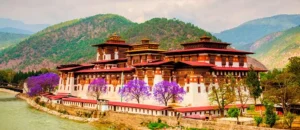
Bhutanese foods and drinks you have to try:
Bhutanese food is simple and rural because it is hard to find ingredients in the harsh climate of the Himalayas. Bhutanese food is mostly made with rice, both Bith red rice and white rice (menu mate), a nutty-seasoned variety that has been grown for a long time on the country’s slopes. Many farmers also grow buckwheat and maize. It came from India and China, and many Bhutanese recipes taste better with bean stew.
Darshi Ema:
The word “Datshi” in Bhutanese means “cheese,” which is what they use in many recipes. The most famous is Ema Datshi, which tastes like a stew made with chilies and cheddar (the word “Ema” means “chilies”) and might be too hot for some. When to go to Bhutan
Ema Datshi is the national dish of Bhutan, so it is without a doubt the most famous dish in the country. When people talk about Bhutanese food, they can’t help but talk about it. When to go to Bhutan
Ike Datshi:
Kewa means potato, so Kewa Datshi is made with potatoes and Bhutanese cheese. Bhutanese food like this is pretty mild, but it’s all about potatoes and cheese. When to go to Bhutan
Phaksha Paa:
A classic Bhutanese stew made with boneless pork shoulder, daikon radish, ginger, bok choy, and, you guessed it, stew powder. The pork is cooked slowly until it is tender. When to go to Bhutan
As soon as the stew is done, it is served with rice and topped with dried pork and new green bean stew strips. When to go to Bhutan
Jumpa:
Juma is a basic Bhutanese hotdog made with ground meat, rice, and a few light spices that are stuffed into stomach organs. When to go to Bhutan
The Yaksha Shakam:
Dried yak meat is the only meat that can be compared to and is better than dried beef. Yak tastes a lot like meat, but it has a slightly different smell (without being too gamey), and it seems to be very good for you. When to go to Bhutan
Paa:
Another version of this food is called Sicaam Paa. It is made with a sun-dried pork stomach that is seared with dry chilies. When to go to Bhutan
Shakam Datshi:
Another type of this food is Shakam Datshi, which is made with dried Bhutanese hamburger, which is a common type of meat. The meat has been dried and stored, but it’s not completely dry. Then cheese and oil are added and cooked for a while.
Types of Drinks:
Along with your dinner, you will be able to choose from a variety of drinks, such as dark and green tea, brew, and wine. Anyhow, if you’re really lucky, you might be given a glass of freshly made ara (or arag), which is an aged drink made from rice, corn, millet, or wheat. Ara has a taste that is similar to an extremely strong purpose. Stay healthy!’
Butter tea from Bhutan – Suja:
In Bhutan, people usually drink coffee, but sometimes they eat tea. People in the area like to drink margarine tea, which is also known as Suja, Po Cha, or Goor. It is usually given after dinner and is very comforting in the cold weather. When to go to Bhutan
Things to Do in Bhutan:
Because it is in the Himalayas, the area is a hub for some extreme sports that will blow your mind and make you feel excited in a way that you never thought possible in such a strict and deep place.
Experience sports in Bhutan include things like exploring, boating, kayaking, rock climbing, and a lot more cool names. As an alternative, you can go to the Tiger’s Nest, a cloister built into a Paro rock 10,000 feet above sea level.
Hiking:
Bhutan is a great place to go on vacation because it has beautiful scenery all around, including snow-covered mountains, grassy plains, lush green valleys, densely forested areas, and crystal-clear lakes. People who are new to visiting can find easy to scary ways to see Bhutan because its landscape is always changing. When to go to Bhutan
Moderate to Hard Level of Difficulty:
March, April, and May are the best months, as well as September, October, and November.
You can go on the Jomolhari Trek, the Druk Path Trek, the Merak Sakteng Trek, the Snowman Trek, the Nabji Korphu Trek, and many other hikes in Bhutan. When to go to Bhutan
Go to Festivals:
It was said that Bhutan is the place where people are most likely to be happy. Bhutanese culture is full of different traditions and festivals that are praised all over the country with a lot of care and energy. If you go on a celebration trip to this country with beautiful scenery and lively events, you can enjoy and experience the lively local customs of the country.
Places: All over Bhutan. When to go to Bhutan
Racing:
Unlike the stereotypical image of boating where you have to fight the strong currents and rapids while yelling with joy and excitement, boating in Bhutan lets you gently float down the stream while taking in the beauty of the area and going through some gentle but thrilling rapids.
Level of Difficulty: Medium. When to go to Bhutan
March, April, May, and October or November are the best months to go.
The most famous boating routes in Bhutan are along the Po Chu River, which has about 16 km of moderately rough rapids, and the Mo Chu River, which has 10 km of calmer rapids.
A Bike:
Bhutan might be the best place to go hiking because of the scenery and the tough mountains. Cycling is probably the best thing to do in Bhutan. Depending on your skills and level of experience, you can do both out-and-about and rough-terrain rides.
October through December and March through April are the best times.
If you want to go biking, the best path is from Thimphu to Dochula Pass. There are also many moderate and shorter routes near the cities of Paro and Thimphu.
Camping:
Going camping outside in the woods, with the Himalayas in the background and tall trees all around, might be the most hypnotic experience ever. Also, Bhutan is probably the best place to see what it’s like to sleep in the mountains and wake up to a beautiful sunrise.
The best times are before and after winter. Summers and monsoons are usually a bit too rough, which could ruin your trip.
Where—There are a number of hiking trails near Thimphu and Paro where you can camp with guides from the area.
Things Not to Do in Bhutan:
The Kingdom of Bhutan is in the Himalayas and is probably the most surprising place that only a few travelers get to because of its location, cost, or difficulty of getting there. But before you go to Bhutan, you should know a few things. When to go to Bhutan
Try not to smoke in public during the day:
If you are going to a strict place like a sanctuary, religious community, dzong, or chorten, or if you are in an open building, try not to wear shorts. This might seem like not caring.
Assign trash cans and don’t throw trash anywhere else:
A good rule of thumb is to not take pictures inside temples, cloisters, dzongs, and chortens.
Do not touch the monks’ robes, any paintings or canvases, or some other items used for ceremonies.
Many people believe that lakes are holy places where gods live, so don’t throw anything into them, swim in them, or mess with the water.
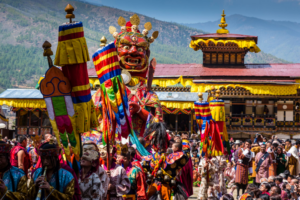
People Who Travel By TravelJunction Hack
Love Easy Way for Couples to Travel:
You can make your honeymoon in Bhutan a romantic trip, and the interesting weather should make you happy. Plan a trip from India to Bhutan for your dream vacation that can be changed to fit your needs.
Bhutan has a lot to offer besides visiting amazing sites. You can go whitewater rafting, rock climbing, kayaking, fishing, traveling, using arrows as weapons, mountain trekking, paragliding, and visiting hot springs. There is no doubt that these things will make your honeymoon interesting.
How to Get Travelers Hack for Free:
We know what a family needs on a trip and try to give it to them. Tour My India makes it easy for you to feel at ease. With our large selection of Bhutan family visit packages, we make it easy for you to have great trips with your family.
Bhutan is one of the most beautiful and unique countries in Asia. It is surrounded by the great Himalayas. Travelers who book Bhutan family visit packs can look forward to beautiful scenery, a lively local culture, and a cozy atmosphere.
Take a family trip to Bhutan to learn about Buddhist culture. The mix of modern and traditional styles will amaze you. Bhutan is easy to get to thanks to its well-organized streets and number of domestic and international airports.
This is a Travelers Hack for Friends:
Indian citizens who want to visit Bhutan must bring either a valid passport or a voter ID card, which is issued by the Election Commission of India for a short-term passing permit. Indian tourists who want to cross the street should get an Entry Permit from the Royal Government of Bhutan’s Immigration Office in Phuentsholing.
When tourists fly, they can get the section grant at the Paro International Airport, as long as they have one of the trip documents listed above.
As important proofs of identity for children (under 18 years old), to show a birth certificate and any photo ID card (school ID card). Both must be in English.
If any of these records are in a language that isn’t English, you should have them translated into English by an official government interpreter.